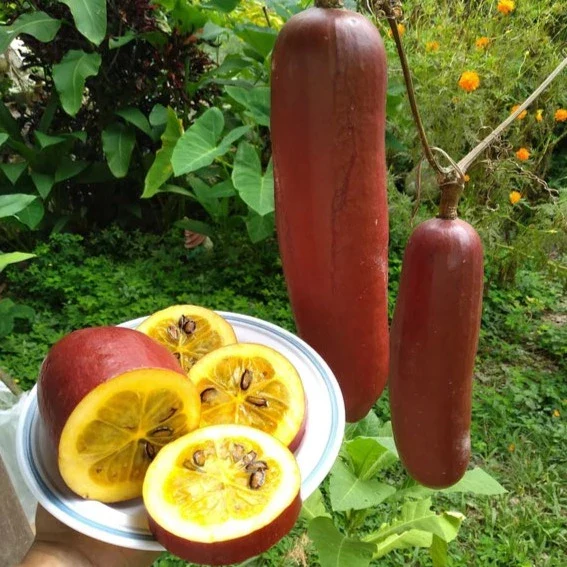Uncategorized
Cassabanana: The Tropical Fruit You’ve Probably Never Heard Of (But Should Grow!)

If you’re a fan of exotic fruits or love cultivating rare plants in your garden, the Cassabanana (Sicana odorifera) deserves a spot on your radar—and maybe even in your backyard. With its striking appearance, fragrant aroma, and surprising versatility, this tropical vine is as useful as it is beautiful.buy Cassabanana online
What Is Cassabanana?buy Cassabanana online
Cassabanana (also known as Sicana, melocotón, or fig-leaf gourd) is a large, fast-growing tropical vine native to South and Central America. It belongs to the cucumber family (Cucurbitaceae), which might surprise you considering its size and flavor.
The plant is known for its massive, melon-like fruits that can grow up to 2 feet long and weigh as much as 10 pounds. The fruits come in shades of deep purple, maroon, or orange, with smooth, waxy skin and a sweet, musky fragrance that intensifies as the fruit ripens.
A Feast for the Senses buy Cassabanana online
Cassabanana is prized for its:
- 🍈 Fragrant aroma – The fruit releases a strong, sweet scent, often used to freshen up rooms. Some even use it as a natural air freshener.
- 🍯 Sweet flesh – Inside, the flesh is golden-orange, with a mildly sweet, melon-like flavor. It’s typically eaten when very ripe.
- 🌿 Climbing vines – The plant’s large, decorative leaves and rapid growth make it an excellent ornamental climber for trellises, fences, or arbors.
How to Eat Cassabanana
While it’s not as juicy as a watermelon or as tangy as a pineapple, ripe cassabanana has a unique, mild sweetness with notes of cantaloupe and banana. Here are a few popular ways to enjoy it:
- Fresh: Scoop out the soft pulp and eat it as-is, especially when fully ripe.
- Cooked: In many cultures, it’s used in stews, jams, and preserves.
- Desserts: Blend it into smoothies, pies, or custards.
- Traditional Uses: In some regions, it’s cooked with sugar and cinnamon to make a sweet, pudding-like treat.
💡 Tip: The fruit should be fully ripe (soft and aromatic) before eating raw. Unripe fruit is hard and bland.
Growing Cassabanana
Cassabanana is a vigorous, heat-loving vine that grows well in warm, tropical or subtropical climates. With the right conditions, it can grow up to 40 feet or more in a single season!
Basic Growing Requirements:
- 🌞 Climate: Prefers tropical/subtropical zones (USDA 9–11).
- 🪴 Soil: Well-drained, rich soil with organic matter.
- 💧 Watering: Consistent moisture, but not soggy.
- 🪜 Support: Needs strong vertical support—trellises or fences work well.
- 🌼 Pollination: Produces male and female flowers; hand-pollination may help in smaller gardens.
🌱 From Seed to Fruit: Cassabanana is grown from seed. It germinates in warm soil (70–85°F), and fruit usually matures 4–5 months after planting.
Why You Should Grow It
Cassabanana isn’t just a curiosity—it’s a multi-functional plant:
- ✅ Edible fruit with culinary potential
- ✅ Natural air freshener with long-lasting aroma
- ✅ Fast-growing vine for shade, privacy, or ornamental use
- ✅ Cultural significance in South American traditions
Final Thoughts
In a world filled with trendy superfoods and flashy imports, the humble Cassabanana remains a hidden gem. Whether you’re looking for a beautiful climber, an unusual fruit to impress your friends, or a sustainable way to scent your home, this tropical vine delivers on all fronts.
